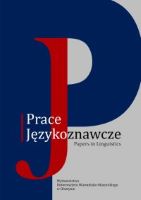Palatalne spółgłoski wargowe w wygłosie. Reminiscencje pod wpływem postaci (orto)graficznych w słowniku języka polskiego i rosyjskiego z końca XIX w.
Final labial-palatal consonants. Reminiscences inspired by (ortho)graphic forms in a Polish-Russian dictionary from the late 19th c.
Author(s): Jolanta MędelskaSubject(s): Cultural history, Social history, Morphology, Lexis, Western Slavic Languages, 19th Century
Published by: Wydawnictwo Uniwersytetu Warmińsko-Mazurskiego w Olsztynie
Keywords: 19th c. Polish language; final labial-palatal consonants; diacritization;
Summary/Abstract: Lexis with a final labial-palatal consonant was excerpted from a Polish-Russian and Russian-Polish dictionary published in Warsaw in the 1870s. The set contains about 80 units attested by about 230 occurrences. These are mainly nouns of the gołąb’ or kotew’ type, as well as numerals ośm’ and siedm’ and a few imperative forms, e.g. mów’. The study found that there is chaos characteristic of the 19th c. in the diacritization of final consonants. This issue – despite the hardening of the relevant consonants in the pronunciation of the majority of educated speakers of Polish – was finally regulated as late as in the 1890s. The Polish-Russian part of the dictionary seems to reflect the theoretical norm, the RussianPolish part – the usage, i.e. the abandonment of diacritization, disrupted by the awareness of the existence of rules imposing the use of redundant diacriticized letters.
Journal: Prace Językoznawcze
- Issue Year: 24/2022
- Issue No: 2
- Page Range: 109-124
- Page Count: 16
- Language: Polish

